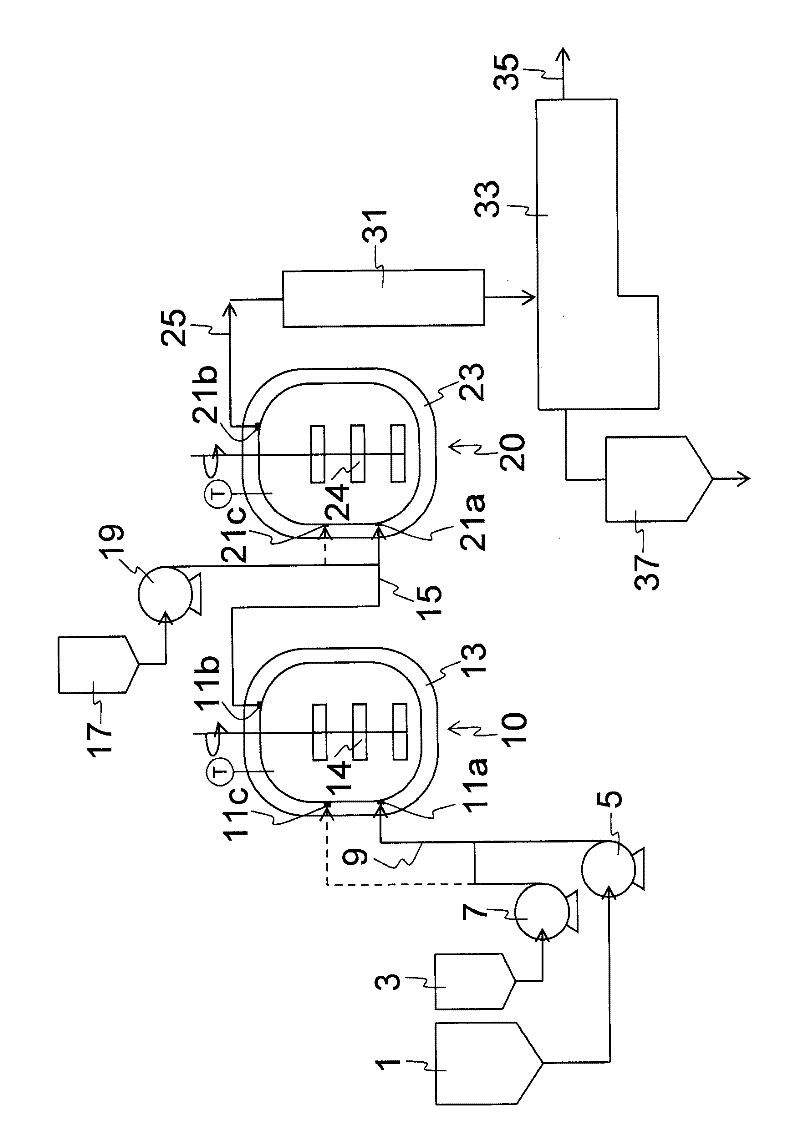Process for Producing Polymer Composition
A composition and polymer technology, applied in the field of polymer composition production, can solve problems such as high viscosity, lowering the quality of polymer composition resin composition, difficulty in reaction control, etc., and achieve effective production, high thermal stability, and effective quality Effect
- Summary
- Abstract
- Description
- Claims
- Application Information
AI Technical Summary
Problems solved by technology
Method used
Image
Examples
Embodiment 1
[0166] In this example, roughly, refer to figure 1 Continuous polymerization is carried out in two stages according to the embodiment described above to produce a polymer composition (resin composition) in the form of pellets. More specifically, this is as follows.
[0167] By mixing 98.606 parts by mass of methyl methacrylate and 0.987 parts by mass of methyl acrylate, and adding 0.284 parts by mass of n-octyl mercaptan (as a chain transfer agent), and 0.123 parts by mass of stearin Alcohol (as a release agent) to prepare the raw material monomer mixed liquid 1.
[0168] Polymerization initiator mixed liquid 1 was prepared by mixing 99.820 parts by mass of methyl methacrylate, and 0.180 parts by mass of t-amyl peroxy-2-ethylhexanoate as a polymerization initiator.
[0169] A polymerization initiator mixed liquid 2 was prepared by mixing 99.840 parts by mass of methyl methacrylate, and 0.160 parts by mass of 1,1-bis(t-butylperoxy)cyclohexane as a polymerization initiator.
...
Embodiment 2
[0186] In this example, a polymer composition was produced in the form of pellets similarly to Example 1 except for the following.
[0187] Polymerization initiator mixed liquid 1 was prepared by mixing 99.790 parts by mass of methyl methacrylate, and 0.210 parts by mass of t-amyl peroxy-2-ethylhexanoate as a polymerization initiator.
[0188] A polymerization initiator mixed liquid 2 was prepared by mixing 99.860 parts by mass of methyl methacrylate, and 0.140 parts by mass of 1,1-bis(tert-butylperoxy)cyclohexane as a polymerization initiator.
[0189] The temperature in the first reactor 10 was 140°C, and the temperature of the jacket 13 surrounding the outer surface of the first reactor 10 was 140°C in order to carry out continuous polymerization under adiabatic conditions substantially without heat transfer. Further, it was controlled using a jacket formed on the connecting line 15 so that the intermediate composition flowing through the inside of the connecting line 15 wa...
Embodiment 3
[0192] In this example, a polymer composition was produced in the form of pellets similarly to Example 1 except for the following.
[0193] Polymerization initiator mixed liquid 1 was prepared by mixing 99.807 parts by mass of methyl methacrylate, and 0.193 parts by mass of t-amyl peroxy-2-ethylhexanoate as a polymerization initiator.
[0194] A polymerization initiator mixed liquid 2 was prepared by mixing 99.920 parts by mass of methyl methacrylate, and 0.080 parts by mass of 1,1-bis(tert-butylperoxy)cyclohexane as a polymerization initiator.
[0195] The temperature in the first reactor 10 was 150°C, and the temperature of the jacket 13 surrounding the outer surface of the first reactor 10 was 150°C in order to carry out continuous polymerization under adiabatic conditions substantially without heat transfer. Further, it was controlled using a jacket formed on the connecting line 15 so that the intermediate composition flowing through the inside of the connecting line 15 wa...
PUM
 Login to View More
Login to View More Abstract
Description
Claims
Application Information
 Login to View More
Login to View More - R&D
- Intellectual Property
- Life Sciences
- Materials
- Tech Scout
- Unparalleled Data Quality
- Higher Quality Content
- 60% Fewer Hallucinations
Browse by: Latest US Patents, China's latest patents, Technical Efficacy Thesaurus, Application Domain, Technology Topic, Popular Technical Reports.
© 2025 PatSnap. All rights reserved.Legal|Privacy policy|Modern Slavery Act Transparency Statement|Sitemap|About US| Contact US: help@patsnap.com

